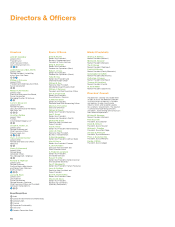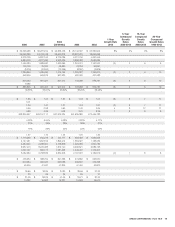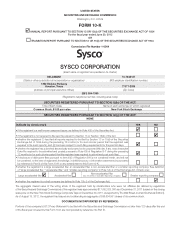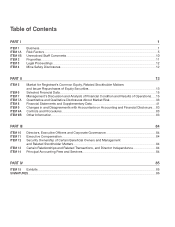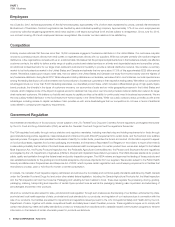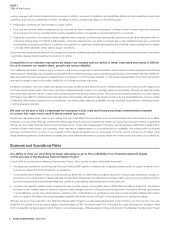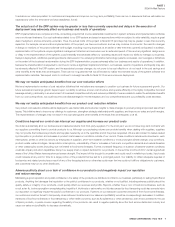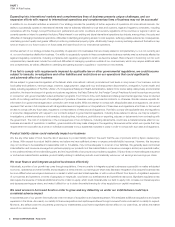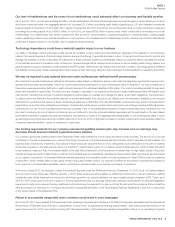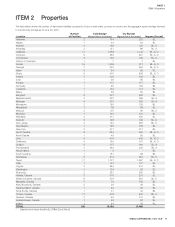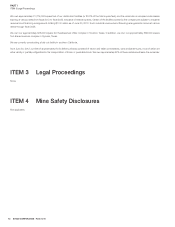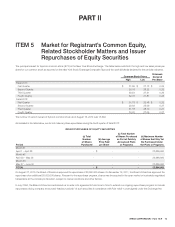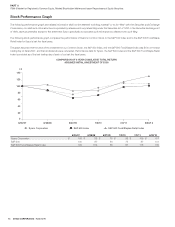Sysco 2012 Annual Report Download - page 27
Download and view the complete annual report
Please find page 27 of the 2012 Sysco annual report below. You can navigate through the pages in the report by either clicking on the pages listed below, or by using the keyword search tool below to find specific information within the annual report.
SYSCO CORPORATION-Form10-K4
PARTI
ITEM1Business
Employees
As of June30,2012, we had approximately 47,800 full-time employees, approximately 17% of whom were represented by unions, primarily the International
Brotherhood of Teamsters. Contract negotiations are handled by each individual operating company. Approximately 17% of our union employees are
covered by collective bargaining agreements which have expired or will expire during fi scal 2013 and are subject to renegotiation. Since June30,2012,
one contract covering 48 of such employees has been renegotiated. We consider our labor relations to be satisfactory.
Competition
Industry sources estimate that there are more than 15,000 companies engaged in foodservice distribution in the UnitedStates. Our customers may also
choose to purchase products directly from retail outlets or negotiate prices directly with our suppliers. While we compete primarily with local and regional
distributors, a few organizations compete with us on a national basis. We believe that the principal competitive factors in the foodservice industry are effective
customer contacts, the ability to deliver a wide range of quality products and related services on a timely and dependable basis and competitive prices.
An additional competitive factor for our larger chain restaurant customers is the ability to provide a national distribution network. We consider our primary
market to be the foodservice market in the UnitedStates and Canada and estimate that we serve about 17.5% of this approximately $225billion annual
market. We believe, based upon industry trade data, that our sales to the UnitedStates and Canada food-away-from-home industry were the highest of
any foodservice distributor during fi scal 2012. While adequate industry statistics are not available, we believe that in most instances our local operations are
among the leading distributors of food and related non-food products to foodservice customers in their respective trading areas. We believe our competitive
advantages include our more than 8,000marketing associates, our diversifi ed product base, which includes a differentiated group of high quality Sysco
brand products, the diversity in the types of customers we serve, our economies of scale and our wide geographic presence in the UnitedStates and
Canada, which mitigates some of the impact of regional economic declines that may occur over time and provides a national distribution network for larger
chain restaurant customers. We believe our liquidity and access to capital provides us the ability to continuously invest in business improvements. We are
the only publicly-traded distributor in the food-away-from-home industry in the UnitedStates. While our public company status provides us with some
advantages, including access to capital, we believe it also provides us with some disadvantages that our competitors do not have in terms of additional
costs related to complying with regulatory requirements.
Government Regulation
As a marketer and distributor of food products, we are subject to the U.S. Federal Food, Drug and Cosmetic Act and regulations promulgated thereunder
by the U.S. Food and Drug Administration (FDA), as well as the Canadian Food and Drugs Act and the regulations thereunder.
The FDA regulates food safety through various statutory and regulatory mandates, including manufacturing and holding requirements for foods through
good manufacturing practice regulations, hazard analysis and critical control point (HACCP) requirements for certain foods, and the food and color additive
approval process. The agency also specifi es the standards of identity for certain foods, prescribes the format and content of information required to appear
on food product labels, regulates food contact packaging and materials, and maintains a Reportable Food Registry for the industry to report when there is
a reasonable probability that an article of food will cause serious adverse health consequences. For certain product lines, we are also subject to the Federal
Meat Inspection Act, the Poultry Products Inspection Act, the Perishable Agricultural Commodities Act, the Packers and Stockyard Act and regulations
promulgated by the U.S. Department of Agriculture (USDA) to interpret and implement these statutory provisions. The USDA imposes standards for product
safety, quality and sanitation through the federal meat and poultry inspection program. The USDA reviews and approves the labeling of these products and
also establishes standards for the grading and commercial acceptance of produce shipments from our suppliers. We are also subject to the Public Health
Security and Bioterrorism Preparedness and Response Act of 2002, which imposes certain registration and record keeping requirements on facilities that
manufacture, process, pack or hold food for human or animal consumption.
In Canada, the Canadian Food Inspection Agency administers and enforces the food safety and nutritional quality standards established by Health Canada
under the Canadian Food and Drugs Act and under other related federal legislation, including the Canada Agricultural Products Act, the Meat Inspection
Act, the Fish Inspection Act and the Consumer Packaging and Labelling Act (as it relates to food). These laws regulate the processing, storing, grading,
packaging, marking, transporting and inspection of certain Sysco product lines as well as the packaging, labeling, sale, importation and advertising of
pre-packaged and certain other products.
We and our products are also subject to state, provincial and local regulation through such measures as the licensing of our facilities; enforcement by state,
provincial and local health agencies of state, provincial and local standards for our products; and regulation of our trade practices in connection with the
sale of our products. Our facilities are subject to inspections and regulations issued pursuant to the U.S. Occupational Safety and Health Act by the U.S.
Department of Labor, together with similar occupational health and safety laws in each Canadian province. These regulations require us to comply with
certain manufacturing, health and safety standards to protect our employees from accidents and to establish hazard communication programs to transmit
information on the hazards of certain chemicals present in products we distribute.



